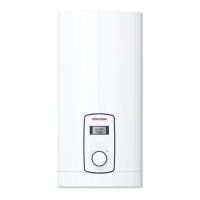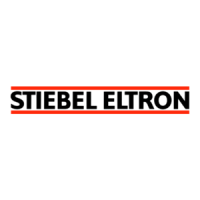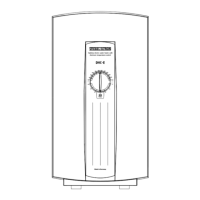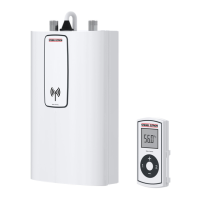INSTALLATION
Installation
ENGLISH
www.stiebel-eltron.com DHB-E LCD | 29
Undersink installation
D0000056242
1
2
1 Cold water inlet
2 DHW outlet
Oversink installation
D0000057030
12
1 Cold water inlet
2 DHW outlet
Note
Mount the appliance on the wall. The wall must have
sufficient load bearing capacity.
9.2 Minimum clearances
≥50≥50
≥90
≥90
D0000060809
Maintain the minimum clearances to ensure trouble-free op-
eration of the appliance and facilitate maintenance work.
9.3 Water installation
Flush the water line thoroughly.
Taps/valves
Use appropriate pressure taps. Open vented taps are not per-
missible.
Note
Never use the 3-way ball shut-off valve in the cold water
inlet to reduce the flow rate. The 3-way ball shut-off valve
is intended only to shut off the cold waterinlet.
Permissible water line materials
- Cold water inlet line:
Pipes made from galvanised steel, stainless steel, copper or
plastic
- DHW outlet line:
Pipes made from stainless steel, copper or plastic
!
Material losses
If plastic pipework systems are used, take into account
the maximum inlet temperature and the maximum per-
missible pressure.
Flow rate
Ensure that the flow rate for switching on the appliance is
achieved.
Increase the water line pressure if the required flow rate is
not achieved when the draw-off valve is fully open. If the
flow rate is not reached despite increasing the pressure, re-
move the flow limiter and install the plastic profile washer.
2
1
26�02�02�0820
1 Flow limiter
2 Plastic profile washer
Note
For the thermostatic valve to function correctly, the flow
limiter must not be replaced with the plastic profile wash-
er.
10. Installation
Factory settings DHB-E 11/13 LCD DHB-E 18 LCD 25A DHB-E 18/21/24 LCD DHB-E 27 LCD
Internal anti-scalding protection in °C 60 60 60 60
Connected load in kW 13.5 18 21 27
Standard installation DHB-E 11/13 LCD DHB-E 18 LCD 25A DHB-E 18/21/24 LCD DHB-E 27 LCD
Electrical connection from below on unfinished walls x x x x
Water connection on unfinished walls x x x x
For further installation options, see chapter "Alternative instal-
lation methods".

